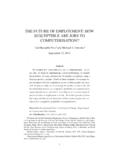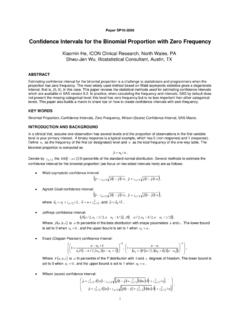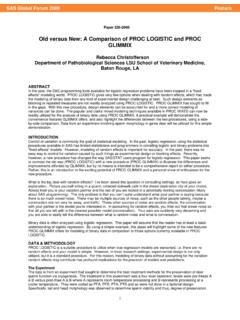Transcription of 261-30: Manipulating Data with PROC SQL
1 1 Paper 261-30 Manipulating data with PROC SQL Kirk Paul Lafler, Software Intelligence Corporation ABSTRACT PROC SQL is a popular database language with numerous extensions for working with numeric and character data including an assortment of operators, functions, and predicates. This paper presents coding techniques that perform text case conversions, concatenation of two or more character strings, pattern and phonetic matching operations, updates to data in a table, and other useful coding techniques for SAS and PROC SQL users. INTRODUCTION PROC SQL provides numerous arithmetic, statistical, and summary functions to manipulate numeric data .
2 with one numeric data type to represent numeric data , the NUMERIC or NUM column definition is automatically assigned a default length of 8 bytes, even if the column is created with a numeric length less than 8 bytes. PROC SQL also provides numerous functions and operators to manipulate character data including words, text, and codes using the CHARACTER or CHAR data type. The CHARACTER or CHAR data type allows ASCII or EBCDIC character sets and stores fixed-length character strings consisting of a maximum of 32K characters. The PROC SQL user has a vast array of functions and operators that can make the task of working with numeric and character data considerably easier.
3 This paper will illustrate how columns based on the numeric and character data types are defined; how string functions, pattern matching, phonetic matching techniques, and a variety of other techniques are used with numeric and character data . data USED IN EXAMPLES The data used in all the examples in this paper consists of a selection of movies that I ve viewed over the years. The Movies table consists of six columns: title, length, category, year, studio, and rating. Title, category, studio, and rating are defined as character columns with length and year being defined as numeric columns. The data stored in the Movies table is depicted below.
4 MOVIES Table SUGI 30 Tutorials 2 SQL OPERATORS AND FUNCTIONS PROC SQL users have a number of ways to accomplish their objectives, particularly when the goal is to manipulate data . The SELECT statement is an extremely powerful statement in the SQL language. Its syntax can be somewhat complex because of the number of ways that columns, tables, operators, and functions can be combined into executable statements. There are several types of operators and functions in PROC SQL: 1) comparison operators, 2) logical operators, 3) arithmetic operators, 4) character string operators, and 5) summary functions. Comparison Operators Comparison operators are used in the SQL procedure to compare one character or numeric values to another.
5 As in the data step, PROC SQL comparison operators, mnemonics, and their descriptions appear in the following table. SAS Operator Mnemonic Operators Description = EQ Equal to ^= or = NE Not equal to < LT Less than <= LE Less than or equal to > GT Greater than >= GE Greater than or equal to Say, for example, that you wanted to select only those movies from the MOVIES table that had a running length longer than 2 hours (120 minutes). The following example illustrates the use of the greater than sign (>) in a WHERE clause to select movies that meets the WHERE clause condition. PROC SQL Code PROC SQL; SELECT title, rating, length FROM WHERE length > 120; QUIT.
6 Results Title Rating Length Brave Heart R 177 Dracula R 130 Forrest Gump PG-13 142 Ghost PG-13 127 Jaws PG 125 Jurassic Park PG-13 127 Scarface R 170 Star Wars PG 124 The Hunt for Red October PG 135 Titanic PG-13 194 Logical Operators Another type of operator known as a logical operator is used to connect two or more expressions together in a WHERE or HAVING clause.
7 The available logical operators include AND, OR, and NOT. Say, for example, you wanted to select only those movies with a running length of more than 2 hours (>120 minutes) and a rating of PG . The next example illustrates how the AND operator is used to ensure that both conditions are true. SUGI 30 Tutorials 3 PROC SQL Code PROC SQL; SELECT title, rating, length FROM WHERE length > 120 AND rating = PG ; QUIT; Results Title Rating Length Jaws PG 125 Star Wars PG 124 The Hunt for Red October PG 135 The next example illustrates the use of the OR logical operator to select movies with a running length of more than 120 minutes or a rating of PG.
8 PROC SQL Code PROC SQL; SELECT title, rating, length FROM WHERE length > 120 OR rating = PG ; QUIT; Results Title Rating Length Brave Heart R 177 Casablanca PG 103 Dracula R 130 Forrest Gump PG-13 142 Ghost PG-13 127 Jaws PG 125 Jurassic Park PG-13 127 Poltergeist PG 115 Rocky PG 120 Scarface R 170 Star Wars
9 PG 124 The Hunt for Red October PG 135 Titanic PG-13 194 SUGI 30 Tutorials 4 Arithmetic Operators The arithmetic operators used in PROC SQL are the same as those used in the data step and other languages including C, Pascal, FORTRAN, and COBOL. The arithmetic operators available in the PROC SQL appear below. Operator Description + Addition - Subtraction * Multiplication / Division ** Exponent (raises to a power) = Equals To illustrate how arithmetic operators are used, suppose you desired to add ten minutes to the running length of each movie in the MOVIES table due to the splicing of corporate advertisements.
10 The next example illustrates the use of the addition arithmetic operator with the definition of a user-defined column alias to accomplish this task. PROC SQL Code PROC SQL; SELECT title, rating, length, length + 20 AS Revised_Length FROM ; QUIT; Results Revised_ Title Rating Length Length Brave Heart R 177 197 Casablanca PG 103 123 Christmas Vacation PG-13 97 117 Coming to America R 116 136 Dracula R 130 150 Dressed to Kill R 105 125 Forrest Gump PG-13 142















